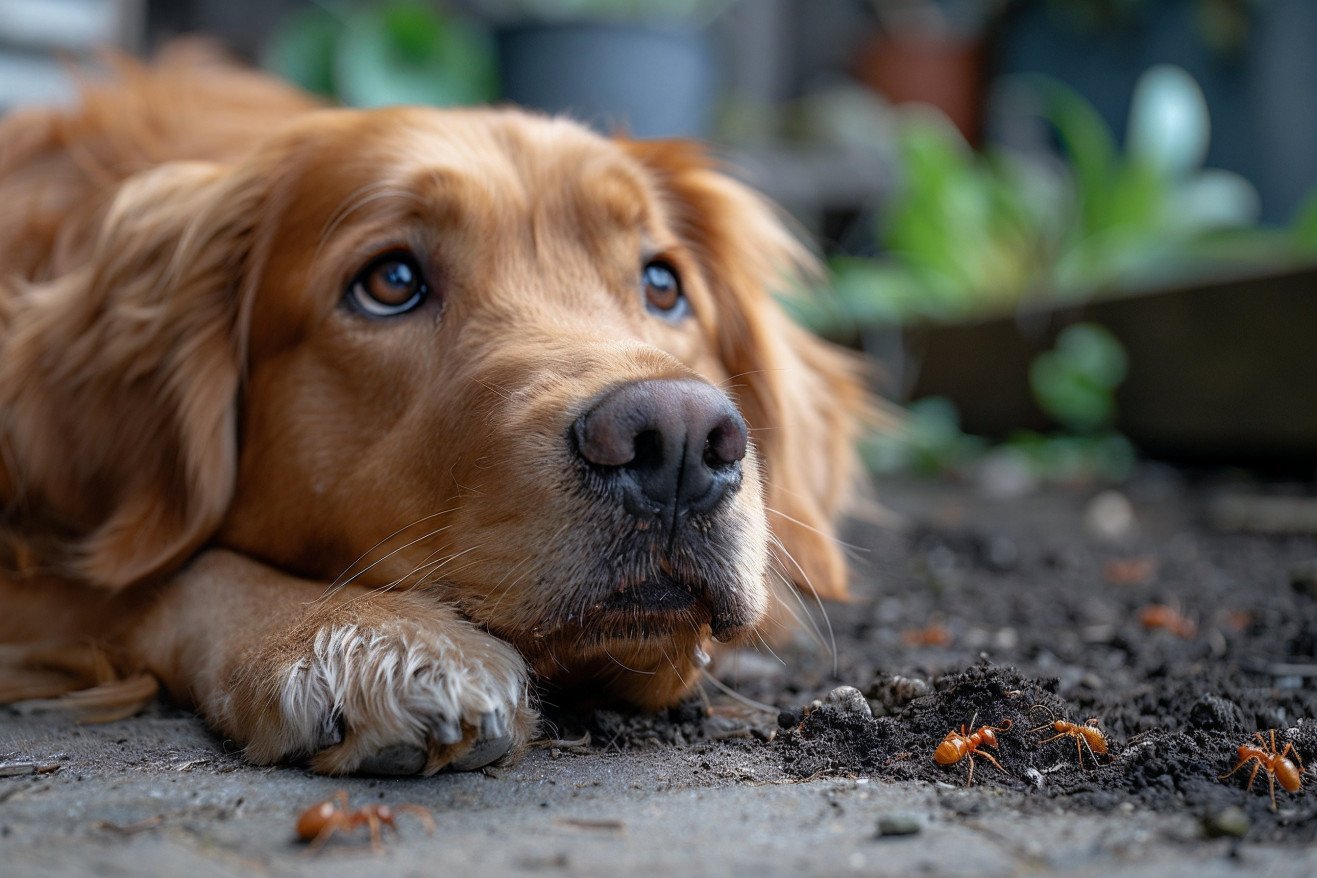Ant Bites on Dogs: Signs, Treatment, and How to Avoid Ant Bites
19 March 2024 • Updated 19 March 2024

Even man’s best friend can’t escape the wrath of nature’s tiniest predators: ants. Ant bites can lead to redness, swelling, and itching in dogs. Mild reactions can be treated with cool compresses and antihistamines.
However, dogs who have more severe reactions, like swelling and hives or trouble breathing, will need to see a vet. You can avoid ant bites by staying away from areas where ants are known to be and getting rid of ant hills in your yard.
In this article, we take a deep dive into the impact of ant bites on dogs by examining veterinary journals and animal care studies to learn about the signs, treatments, and ways to prevent ant bites.
We also look at information from the field of entomology to learn about the habits of different types of ants and how they interact with pets. By looking at a variety of studies and expert opinions, we can help you understand how to keep your dog safe from these small but potentially dangerous ants.
How can you spot, treat, and avoid ant bites on dogs?
How to Tell if Your Dog Has Been Bitten by Ants and How to Treat the Bites
It is important to know the signs of ant bites so that you can quickly treat your dog if they are bitten. The most common signs of ant bites are red, raised welts, itching, and swelling, which are all signs of a mild allergic reaction.
More severe allergic reactions can include hives, more extreme swelling, difficulty breathing, and even anaphylactic shock, which is life-threatening. According to VCA Animal Hospitals, these allergic reactions require immediate medical care.
If your dog is experiencing a mild allergic reaction to ant bites, you can treat them at home. You can make a paste out of baking soda and water and apply it to the affected area. You can also use ice packs to help reduce swelling, and you can give your dog oral antihistamines like diphenhydramine (in doses approved by your vet) to help with other allergic symptoms.
You can also use an Elizabethan collar to keep your dog from scratching the bite, which can make it worse, according to The Spruce Pets.
If your dog is experiencing a more severe allergic reaction to ant bites, which can include symptoms like vomiting, excessive drooling, and restlessness, you should contact your vet immediately, according to The Spruce Pets.
After your dog has been treated, make sure to watch them for any signs of lingering or worsening symptoms, which could mean that they need more medical care. Getting your dog treated for ant bites as soon as possible can help relieve their symptoms and prevent more serious complications.
Long-Term Impact of Ant Bites on Dogs
While dog owners may be most concerned with the short-term impact of ant bites, it’s important to realize that there may be long-term effects that develop. Dogs that are bitten by ants repeatedly may develop chronic allergies or infections that continue to impact their health.
The dog’s immune system will determine how it responds to these encounters and how well it can recover, and a weakened immune system may make the dog more susceptible to more serious or long-term effects.
One study found that venomous bites and stings can have long-term effects on dogs that require ongoing veterinary care. In the most severe cases, chronic pain, tissue damage, and loss of mobility may result, highlighting the importance of early and effective treatment.
In addition, a study in the Canadian Veterinary Journal found that dietary changes may be helpful in managing long-term allergic reactions. For example, the addition of insect protein to a dog’s diet may help alleviate skin allergies that are often seen in dogs with food sensitivities.
Proper dietary management, which may include the use of novel proteins or a carefully balanced home-cooked diet that’s been formulated by a veterinary nutritionist, can help support the immune system and improve the dog’s quality of life following ant bites. By ensuring that their dog receives the right care and nutritional support, dog owners can help ensure that their pet enjoys the best possible long-term health and well-being.
What to Do If Your Dog Is Bitten by Ants
The treatment for ant bites in dogs depends on the severity of the reaction. For mild cases, oral antihistamines like diphenhydramine (Benadryl) can be used to relieve allergic symptoms, says VCA Animal Hospitals. If the reaction is not resolved or the dog has a hypersensitivity reaction, corticosteroids can be prescribed to reduce inflammation.
If the reaction is severe and includes respiratory distress or anaphylaxis, the dog may need to be hospitalized. In these cases, the dog will be treated with epinephrine, intravenous fluids, oxygen therapy, and monitored for signs of organ damage, according to VCA Animal Hospitals.
For dogs that have had multiple allergic reactions to ant bites, veterinarians may recommend allergy testing and immunotherapy. This treatment is designed to identify the specific allergens that are causing the reaction and then work to desensitize the dog’s immune system to those allergens.
Always consult with a licensed veterinarian when considering treatment options and take into account the dog’s individual health and the severity of their symptoms. It’s also important to make sure that you’re keeping a close eye on your dog’s environment and their potential exposure to ants.
Protecting Your Dog from Ant Bites
Good environmental control is the key to preventing ant bites in dogs. By eliminating anthills and ensuring that ants can’t thrive in your yard, you can greatly reduce the likelihood of your dog getting bitten.
Family Handyman explains that good housekeeping, especially in the kitchen, can help keep ants from coming into your home to look for food.
When it comes to outdoor control, Diatomaceous Earth (DE) is a popular non-toxic option that is safe for pets as long as it is used properly. The Pest Informer recommends pet-friendly ant baits like TERRO T300B Liquid Ant Killers, which are made with low-toxicity ingredients like borax, which is safe for pets in small amounts.
Training your dog to stay away from areas where ants are present when you’re outside can also help. If you’re looking for natural ways to keep ants away from your dog, Family Handyman explains that vinegar and lemon juice can disrupt ant trails without harming pets. However, essential oils should be avoided since they can be toxic to dogs and cats.
By using these methods and products, you can help ensure that your dog is safe from ants and ant bites. With careful prevention and the right pest control methods, you can make sure that your dog stays safe and healthy.
Breaking Down the Dangers: Types of Ants and Their Impact on Dogs
Of the many species of ants, the most dangerous to dogs are the aggressive and venomous fire ants. As explained by MYOS Pet’s veterinary advisor Dr. Albert Ahn and reported by National Geographic, fire ants are known for their swarming behavior and venom that contains piperidine, an alkaloid that can cause significant pain and swelling. These symptoms can be mild to severe and even lead to anaphylactic shock in some cases.
The strength of fire ant venom means that anaphylaxis is more likely to occur after a bite, and the symptoms of an allergic reaction in dogs can depend on the type of ant that bites them.
While ants like carpenter, pavement, and sugar ants are unlikely to cause problems, fire ants, which can be identified by their reddish-brown to black coloring, are a different story. Their aggressive nature means that any dog that accidentally crosses their path will be in for a world of pain.
Dog owners need to be aware of their surroundings to protect their pets from these small but mighty creatures. This includes regular checks of their yard for ant activity and avoiding areas where fire ants are known to live. Knowing which ants to be aware of can help dog owners keep their pets safe from the not-so-sweet sting of nature’s little predators.
Protecting Our Pups: What You Need to Know About Ant Bites
Throughout our quest to protect our dogs from ant bites, we’ve discussed the importance of recognizing symptoms, which can range from mild skin irritation and redness to anaphylactic shock, a potentially life-threatening allergic reaction. As PetMD points out, the key to this is recognizing the symptoms and then responding appropriately, from washing away fire ants to giving antihistamines like Benadryl with veterinary supervision, and in the most severe cases, hospitalization.
We’ve also talked about the importance of being proactive in terms of environmental control, including using ant killers that are safe for pets, such as the TERRO T300B Liquid Ant Killers recommended by Pest Informer, to keep these pests from hurting our dogs. In addition, the role of dog owners in staying away from ant-infested areas and learning about the different species of ants, especially the aggressive fire ants, cannot be overstated.
Veterinary care is important when it comes to treating ant bites, which highlights the importance of regular health care for our pets. Through education and preparation, we can make sure our dogs stay safe and healthy. After all, it’s up to us to protect our loyal friends from the small dangers that can hide in the grass.


